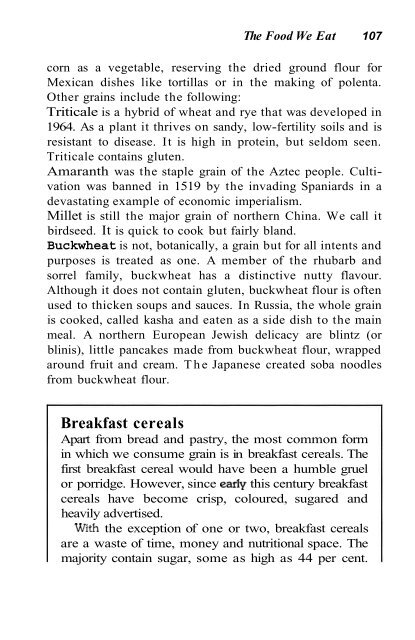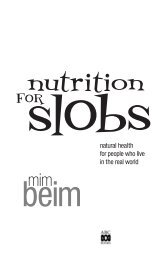Eating Well - Beaming with Health
Eating Well - Beaming with Health
Eating Well - Beaming with Health
You also want an ePaper? Increase the reach of your titles
YUMPU automatically turns print PDFs into web optimized ePapers that Google loves.
The Food We Eat 107<br />
corn as a vegetable, reserving the dried ground flour for<br />
Mexican dishes like tortillas or in the making of polenta.<br />
Other grains include the following:<br />
Triticale is a hybrid of wheat and rye that was developed in<br />
1964. As a plant it thrives on sandy, low-fertility soils and is<br />
resistant to disease. It is high in protein, but seldom seen.<br />
Triticale contains gluten.<br />
Amaranth was the staple grain of the Aztec people. Cultivation<br />
was banned in 1519 by the invading Spaniards in a<br />
devastating example of economic imperialism.<br />
Millet is still the major grain of northern China. We call it<br />
birdseed. It is quick to cook but fairly bland.<br />
Buckwheat is not, botanically, a grain but for all intents and<br />
purposes is treated as one. A member of the rhubarb and<br />
sorrel family, buckwheat has a distinctive nutty flavour.<br />
Although it does not contain gluten, buckwheat flour is often<br />
used to thicken soups and sauces. In Russia, the whole grain<br />
is cooked, called kasha and eaten as a side dish to the main<br />
meal. A northern European Jewish delicacy are blintz (or<br />
blinis), little pancakes made from buckwheat flour, wrapped<br />
around fruit and cream. The Japanese created soba noodles<br />
from buckwheat flour.<br />
Breakfast cereals<br />
Apart from bread and pastry, the most common form<br />
in which we consume grain is in breakfast cereals. The<br />
first breakfast cereal would have been a humble gruel<br />
or porridge. However, since early this century breakfast<br />
cereals have become crisp, coloured, sugared and<br />
heavily advertised.<br />
W1th the exception of one or two, breakfast cereals<br />
are a waste of time, money and nutritional space. The<br />
majority contain sugar, some as high as 44 per cent.



